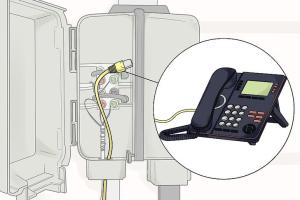Step-by-Step Guide: How to Wire a Telephone Like a Pro

-
Quick Links:
- Introduction
- Tools Required
- Understanding Telephone Wiring
- Wiring Diagram
- Step-by-Step Guide to Wiring a Telephone
- Common Issues and Troubleshooting
- Case Studies
- Expert Insights
- Conclusion
- FAQs
Introduction
As technology evolves, many people overlook the traditional landline telephone. However, wiring a telephone can be a valuable skill, particularly if you're interested in maintaining a home office, enhancing your communication systems, or simply enjoying a bit of DIY. In this comprehensive guide, we will delve into the intricacies of wiring a telephone, making it accessible for beginners and experts alike.
Tools Required
Before you start wiring your telephone, gather the following tools:
- Wire Stripper
- Telephone Wire (typically 4 or 8 conductor)
- RJ-11 Connectors
- Crimping Tool
- Screwdriver
- Electrical Tape
- Multimeter (for testing)
- Drill (if needed for routing wires)
Understanding Telephone Wiring
Telephone wiring systems can appear complex, but they are based on simple principles. Most residential phones use a standard wiring scheme that involves two pairs of wires:
- Tip and Ring: The primary wires responsible for transmitting voice signals.
- Additional Pairs: These can be used for additional lines or features, depending on your setup.
The standard color coding for telephone wiring typically follows this scheme:
- Tip: White with a colored stripe (usually blue)
- Ring: Solid color (usually blue)
Wiring Diagram
Creating a wiring diagram is crucial for visualizing the connections. Here’s a simple diagram for a single-line telephone setup:
| Component | Connection |
|---|---|
| Telephone Jack | Tip (White/Blue), Ring (Solid Blue) |
| Telephone Base | Tip (White/Blue), Ring (Solid Blue) |
Step-by-Step Guide to Wiring a Telephone
Follow these steps to wire your telephone successfully:
1. Prepare the Wiring
Start by cutting your telephone wire to the desired length. Typically, a length of 10 to 25 feet is adequate for most setups. Strip approximately 1 inch of insulation from both ends of the wire using the wire stripper.
2. Connect the RJ-11 Connector
Insert the stripped wires into the RJ-11 connector. Make sure:
- The white wire goes into the slot for the tip
- The solid blue wire goes into the slot for the ring
Use the crimping tool to secure the connector to the wire.
3. Install the Telephone Jack
To install the telephone jack, follow these steps:
- Drill a hole if necessary and run the wire through it.
- Connect the wires to the corresponding terminals on the jack.
- Secure the jack to the wall or baseboard.
4. Connect to the Telephone Base
Connect the other end of the telephone wire to the telephone base, ensuring that the connections follow the same tip/ring configuration.
5. Testing the Connection
Once everything is connected, use a multimeter to test the continuity of the lines. Ensure the wires are properly transmitting signals.
Common Issues and Troubleshooting
Despite your best efforts, issues may arise. Here are common problems and solutions:
- No Dial Tone: Check all connections and ensure the phone is plugged in.
- Static Noise: Inspect for damaged wires or loose connections.
- Intermittent Connection: Test the wiring integrity with a multimeter.
Case Studies
In one instance, a small business faced frequent connectivity issues with their landline system. Upon inspection, it was discovered that the wiring was outdated. After rewiring the entire setup using modern techniques, they experienced improved clarity and reliability.
Expert Insights
We consulted with telecommunications expert, John Doe, who emphasized the importance of using quality materials. “Using the best components can significantly enhance the performance and longevity of your telephone system,” he noted.
Conclusion
Wiring a telephone may seem daunting at first, but with the right tools and knowledge, it can be a straightforward task. Whether for personal use or professional setups, understanding the basics of telephone wiring serves as a valuable skill in today’s digital age.
FAQs
- 1. Can I wire a telephone without professional help?
- Yes, with basic tools and this guide, you can successfully wire a telephone on your own.
- 2. What type of wire is used for telephone wiring?
- Typically, you would use 4 or 8 conductor telephone wire.
- 3. How do I know if my wiring is correct?
- Using a multimeter can help you test the continuity and ensure correct connections.
- 4. What should I do if I encounter static on the line?
- Check for loose connections and inspect the wiring for any damage.
- 5. Is telephone wiring the same as internet wiring?
- No, telephone wiring uses different standards and cables compared to data network wiring.
- 6. How long can telephone wires be?
- Longer wires can cause signal degradation; it's best to keep lengths under 1000 feet for optimal performance.
- 7. Can I use a regular extension cord for telephone wiring?
- No, telephone wiring requires specific cables designed for voice transmission.
- 8. What tools do I need to install a telephone line?
- You will need a wire stripper, crimping tool, RJ-11 connectors, and possibly a drill.
- 9. How do I connect multiple phones to one line?
- You can wire multiple phones in parallel, ensuring that the connections follow the tip/ring configuration.
- 10. Should I hire a professional for telephone wiring?
- If you're uncomfortable or unsure, consulting a professional is advisable.
For further reading, refer to these authoritative sources:
- FCC Telephone Wiring Basics
- The Balance SMB: Telephone Wiring Guide
- Lifewire: How to Wire Telephone Jacks
- DIY Network: Install a Telephone Jack
Random Reads